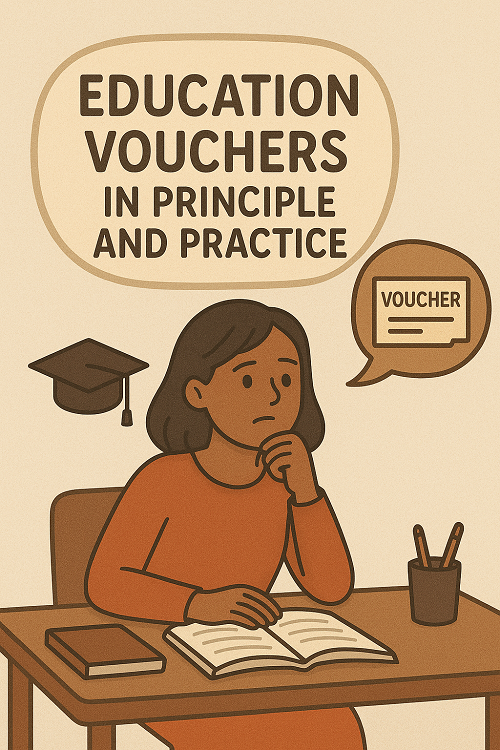An education voucher system exists when governments make
payments to families that enable their children to enter public or private
schools of their choice. The tax funded payments can be made directly to
parents or indirectly to the selected schools; their purpose is to increase
parental choice, to promote school competition, and to allow low income
families access to private schools.
This type of voucher has been adopted by developing countries
notably Bangladesh, Belize, Chile, Colombia, Guatemala, and Lesotho as
well as by industrial countries such as Poland, Sweden, the United
Kingdom, and the United States. Much of the recorded experience with such programs is pertinent to the long-standing theoretical debates on the
desirability of voucher systems.
A tax funded education voucher in the broadest sense is a payment
made by the government to a school chosen by the parent of the child
being educated; the voucher finances all or most of the tuition charged.
The system introduces competition among public schools and between
public and private schools; and it enables schools to offer diverse
educational packages to meet the different preferences of parents.
The goal of all voucher plans to provide families with maximum
choice within a decentralized and competitive system of schools embodies
four principles; consumer choice, personal advancement, the promotion of
competition, and equal opportunity. consumer choice, in education, equals
parental choice; parents choose schools for their children by virtue of their
parental authority and are thus, in a fundamental sense, the real consumers
of education. Under a voucher plan, government serves the consumers of
education parents rather than the suppliers of education schools.
The second principle, that of personal advancement, is rooted in the
conviction that people want to shape their own destinies. The opportunity
to choose and to decide stimulates interest, participation, enthusiasm, and
dedication.
The third principle, the stimulation of competition applies here
because public schools are usually monopolies. The objective of vouchers
is to challenge them to compete with each other and with private schools
through reducing costs, increasing quality, and introducing dynamic
innovation.
The fourth principle the goal of equality of opportunity underlying the
rationale for vouchers is a logical outcome of the other three and is
expressed in the objective of increasing access to private schools.
With vouchers children are not assigned to schools by attendance
zones or any other criterion of the school system. Instead, vouchers enable
parents to select a school for their children among any eligible and
participating schools, public or private. in the most common application of
the voucher principle, known as “funds follow the child”, government
funding is directed straight to the school chosen by the parent. Because it
has no other direct government subsidy, each school is thus in competition
with every other school for students. Good schools attract many students redeem many vouchers, and prosper. Inferior schools, avoided by parents,
are stimulated to improve or must close down.
In 1981 the Assisted places Scheme was established in the United
Kingdom with the aim of providing a ladder of opportunity for able but
poor students, under the scheme today, low income parents can obtain
assistance with tuition fees for an independent school if the school has
been approved by the Department of Education and Science.
By 1995 about 29,800 students were using these selective vouchers at
294 specified independent schools in England (there is a separate system
for Scotland). About 5,000 new pupils enter the program every year.
mostly at the ages of eleven or thirteen.
COLOMBIA
A voucher system was introduced in 1992 and by 1994 was operating
in 216 municipalities, serving 90,807 low income students in 1,789
schools. The vouchers, worth on average about $143, were issued to
students entering the sixth grade. An early examination of the program
confirmed that, as intended, the vouchers were being successfully
allocated exclusively to poor families.
The voucher system was introduced primarily to respond to the shortage of
places in public secondary schools in Colombia, where 40 percent of the
secondary schools are privately owned. The vouchers help poor students
gain access to the private schools; simultaneously, the vouchers benefit the
public secondary schools by reducing overcrowding.
Puerto Rico’s governor, Pedro Rosello, signed a voucher plan into
law in September 1993, which was limited to families earning below a
given income. The vouchers, with $1,500, have been portable between
public schools, as well as from private to public and public to private
schools; religious schools were also included.
During the last two decades governments have become increasingly
unwilling or unable to continue to raise the share of public expenditure
spent on education. The prime focus has switched accordingly to attempts
to obtain higher output from given expenditure levels. The used of
vouchers valued at much less than 100 percent of the cost per pupil in
public schools has already been successful in Sweden, Milwaukee (United States), and Poland, and may become a popular way of economizing.
Economists, meanwhile, see the key role in such efficiency gains to be the
gradual removal of the current monopoly structure in education.
